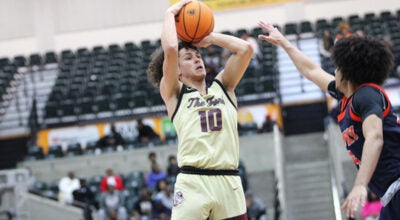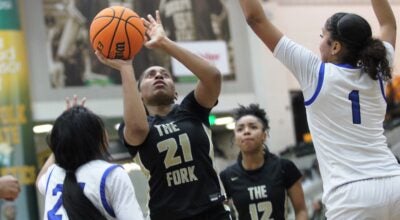Suffolk public school sports realigned
Published 10:03 pm Tuesday, July 30, 2013

Lakeland High School linebacker Jaquan Yulee makes a tackle last season in a district showdown against Nansemond River High School. Practice begins this week for both teams as they enter their first year with the VHSL’s realigned regions. (Melissa Glover photo)
Changes are coming this fall to Suffolk’s public school athletics. A statewide realignment forming new regions and new conferences comes as part of an effort to create fairer competition by grouping schools of similar size together and also giving more teams a shot at a state championship.
“It’s going to be different,” Nansemond River High School principal Thomas McLemore said. “It’s going to be exciting.”
At the most local level, King’s Fork High School, Lakeland High School and Nansemond River High School will now be part of a conference including Denbigh High School, Heritage High School and Phoebus High School, all of which have similar enrollment numbers.
In the current Southeastern District, Suffolk’s schools, which range in size from 1,100 to 1,500 students, are frequently pitted against Chesapeake schools, some of which have student bodies of about 2,300 to 2,400.
In all sports except for football, the Bulldogs, Cavaliers and Warriors will play conference tournaments in which the winner and runner-up advance to the eight-team regional level.
One goal in the midst of the realignment was to avoid interfering with the districts as much as possible. All sports will still have a regular season SED champion, but football will feature more familiar trappings beyond that.
Suffolk schools will still see the familiar district opponents on the gridiron, a regular season district champion will be crowned and power points will dictate who moves on to the regional level. But the regional field will now feature 16 schools, all of similar size.
Suffolk schools were part of the Eastern Region, with schools of widely varying enrollment numbers, and are now part of Region 4A South, with more uniform school sizes.
Formerly, some regions had as few as 16 schools while the Eastern Region had a state-high 39. Now, all regions have 24 to 26 teams.
“That was part of the logic was to try to make these new regions be a little more fairly distributed,” said 4A South representative Susan Bechtol.
For the sports with a sufficient number of teams to compete on the state level, there used to be three state champions in groups organized by school size: A, AA and AAA. There will now be six champions based on school-size groups: 1A, 2A, 3A, 4A, 5A and 6A.
Football was already organized into six divisions, but baseball, basketball and many others will join it in having six state champions.
Bechtol, who is also principal of Churchland High School, was pleased with the changes the Virginia High School League made.
“In almost all of the cases, it also gave more opportunities for students to participate at that higher level,” she said.
Nansemond River activities director Nancy Richey said, “I can’t wait ‘til we get to play in it and see if it has any effect on the morale of the athletes and the student body.”
“It will be good for the kids I think,” said McLemore, who will become the conference chairman. “Gives them something to play for.”
The athletic directors for each Suffolk public school had varying outlooks on the changes.
King’s Fork’s Randy Jessee said, “You really won’t know until it plays out, but I think it kind of takes away from our natural rivalries.” Team schedules will now feature only one match-up against district opponents, and school size differences will eliminate the possibility of meeting them in the playoffs, except for Deep Creek High School, a 4A North school.
Richey felt the issue could be minimized.
“In my perspective, you can still play these old teams, you can still play them as an add-on game, so to speak,” she said.
The mixture of new and old in football has some interesting side effects for Suffolk. Six of the 10 SED schools are in regions with bigger programs (5A and 6A), meaning a victory over them would bring bonus power points.
Lakeland activities director Greg Rountree was not mourning any lost rivalry, though.
“I really don’t think that we had a rivalry with the Chesapeake schools,” he said.
“The only rivalries we really have are King’s Fork and Nansemond River.”
He also highlighted the fact that Suffolk has prior experience with moving, having previously been a part of the Peanut District and the Bay Rivers District.
McLemore actually relished the return of old rivalries that died when Suffolk schools jumped up to Group AAA. Opponents like Smithfield High School and Tabb High School will begin to pop up on the schedule again in certain sports, he noted.






